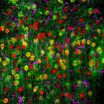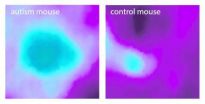(Press-News.org) After a string of penalties aimed in the same direction, goalkeepers are more likely to dive in the opposite direction on the next penalty but kickers fail to exploit this pattern, finds new UCL research.
The study, published in Current Biology, shows that penalty shoot-outs in international tournaments resemble a psychological game. The researchers studied penalty shoot-out videos from all World Cup and Euro finals tournaments between 1976 and 2012.
They found that each team of kickers produced more or less random sequences of kicks to the left or the right of the goal. Goalkeepers' dives to the left or the right were not related to the direction of the kick, suggesting that goalkeepers at this elite level make their decisions in advance, rather than reacting to each kick. However, goalkeepers' decisions were non-random in one crucial respect: when the kickers repeatedly kicked in the same direction on consecutive penalties, goalkeepers became more likely to dive in the opposite direction on the next penalty. The goalkeepers therefore display what has been called the 'gambler's fallacy' – like a person who believes that after coin flips produce a run of 'heads', the next flip is bound to produce 'tails'.
"Complete randomness is generally the best strategy in competitive games" says lead author Erman Misirlisoy of the UCL Institute of Cognitive Neuroscience. "Because the goalkeeper displays the gambler's fallacy, kickers could predict which way the goalkeeper is likely to dive on the next kick. That would obviously give the kicker an advantage – they would simply aim for the opposite side of the goal. Surprisingly, though, we found that kickers failed to exploit this advantage".
"Often you can only win in elite sport by exploiting tiny weaknesses in your opponent's strategy", explains senior author Professor Patrick Haggard. "We can only speculate on why goalkeepers can get away with non-randomness, without the kickers exploiting it. One possibility is that penalty shoot-outs are relatively rare. But there is a more psychologically interesting possibility: shoot-outs are asymmetric, because one goalkeeper faces several different kickers, one after the other. Kickers are under enormous pressure, focussed on the moment of their own kick. Each individual kicker may not pay enough attention to the sequence of preceding kicks to predict what the goalkeeper will do next."
Erman Misirlisoy adds: "People can learn to predict: perhaps football coaches could study the gambler's fallacy, and could train their penalty kickers in preparation for the next World Cup. At the same time, goalkeepers could also learn to be less predictable".
INFORMATION:
The research was supported by the European Research Council and UK Economic and Social Research Council.
Goalkeepers prone to 'gambler's fallacy' but penalty takers fail to exploit it
After a string of penalties aimed in the same direction, goalkeepers are more likely to dive in the opposite direction on the next penalty
2014-07-31
ELSE PRESS RELEASES FROM THIS DATE:
Birthday matters for wiring-up the brain's vision centers
2014-07-31
Researchers at the University of California, San Diego School of Medicine have evidence suggesting that neurons in the developing brains of mice are guided by a simple but elegant birth order rule that allows them to find and form their proper connections.
The study is published online July 31 in Cell Reports.
"Nothing about brain wiring is haphazard," said senior author Andrew Huberman, PhD, assistant professor in the Department of Neurosciences, Division of Biological Sciences and Department of Ophthalmology, UC San Diego.
A mature, healthy brain has billions ...
New mapping approach lets scientists zoom in and out as the brain processes sound
2014-07-31
Researchers at Johns Hopkins have mapped the sound-processing part of the mouse brain in a way that keeps both the proverbial forest and the trees in view. Their imaging technique allows zooming in and out on views of brain activity within mice, and it enabled the team to watch brain cells light up as mice "called" to each other. The results, which represent a step toward better understanding how our own brains process language, appear online July 31 the journal Neuron.
In the past, researchers often studied sound processing in various animal brains by poking tiny electrodes ...
'Rewired' mice show signs of longer lives with fewer age-related illnesses
2014-07-31
VIDEO:
TRAP-1 is a protein vital for the production of chemical energy in the mitochondria of cells, but it is over-produced in tumor cells. The laboratory of Dr. Dario Altieri at...
Click here for more information.
While developing a new cancer drug, researchers at The Wistar Institute discovered that mice lacking a specific protein live longer lives with fewer age-related illnesses. The mice, which lack the TRAP-1 protein, demonstrated less age related tissue degeneration, ...
Drug target identified for common childhood blood cancer
2014-07-31
In what is believed to be the largest genetic analysis of what triggers and propels progression of tumor growth in a common childhood blood cancer, researchers at NYU Langone Medical Center report that they have identified a possible new drug target for treating the disease.
T-cell acute lymphoblastic leukemia is one of the most common and aggressive childhood blood cancers. An estimated quarter of the 500 adolescents and young adults diagnosed with the cancer each year in the U.S. fail to achieve remission with standard chemotherapy drugs.
In a cover-story report ...
Molecule enhances copper's lethal punch against microbes
2014-07-31
DURHAM, N.C. – Harnessing a natural process in the body that pumps lethal doses of copper to fungi and bacteria shows promise as a new way to kill infectious microbes, a team of scientists at Duke University report.
Publishing in the July 31, 2014, issue of the journal Chemistry & Biology, the researchers describe a way of exploiting the unique chemical response from the body's immune system to attack pathogens using copper, long known for its antimicrobial properties, in a way that minimizes harm to the rest of the body.
The findings in cell and animal models represent ...
Master HSF supports reprogramming of normal cells to enable tumor growth and metastasi
2014-07-31
CAMBRIDGE, Mass. (July 31, 2014) – Long associated with enabling the proliferation of cancer cells, the ancient cellular survival response regulated by Heat-Shock Factor 1 (HSF1) can also turn neighboring cells in their environment into co-conspirators that support malignant progression and metastasis.
The finding, reported by Whitehead Institute scientists this week in the journal Cell, lends new insights into tumor biology with significant implications for the diagnosis, prognosis, and management of cancer patients.
Over the past several years, researchers in the ...
Insular cortex alterations in mouse models of autism
2014-07-31
This news release is available in German.
The insular cortex is an integral "hub", combining sensory, emotional and cognitive content. Not surprisingly, alterations in insular structure and function have been reported in many psychiatric disorders, such as anxiety disorders, depression, addiction and autism spectrum disorders (ASD). Scientists from Harvard University and the Max-Planck Institute of Neurobiology in Martinsried now describe consistent alterations in integrative processing of the insular cortex across autism mouse models of diverse etiologies. In particular, ...
C. difficile vaccine proves safe, 100 percent effective in animal models
2014-07-31
An experimental vaccine protected 100 percent of animal models against the highly infectious and virulent bacterium, Clostridium difficile, which causes an intestinal disease that kills approximately 30,000 Americans annually. The research is published ahead of print in Infection and Immunity.
In the study, the vaccine protected the mice and non-human primates against the purified toxins produced by C. difficile, as well as from an orogastric spore infection, a laboratory model that mimics the human disease, after only two immunizations.
"Animals that received two ...
Scientists find growing consensus: Political attitudes derive from body and mind
2014-07-31
Lincoln, Neb., July 31, 2014 -- Do people make a rational choice to be liberal or conservative? Do their mothers raise them that way? Is it a matter of genetics?
Two political scientists from the University of Nebraska-Lincoln and a colleague from Rice University say that neither conscious decision-making nor parental upbringing fully explain why some people lean left while others lean right.
A growing body of evidence shows that physiological responses and deep-seated psychology are at the core of political differences, the researchers say in the latest issue of the ...
Strict genomic partitioning by biological clock separates key metabolic functions
2014-07-31
Irvine, Calif., July 31, 2014 — Much of the liver's metabolic function is governed by circadian rhythms – our own body clock – and UC Irvine researchers have now found two independent mechanisms by which this occurs.
The study, published online today in Cell, reveals new information about the body clock's sway over metabolism and points the way to more focused drug treatments for liver disease and such metabolic disorders as obesity and diabetes.
Paolo Sassone-Corsi, UCI's Donald Bren Professor of Biological Chemistry, and postdoctoral scholar Selma Masri report that ...
LAST 30 PRESS RELEASES:
Securing AI systems against growing cybersecurity threats
Longest observation of an active solar region
Why nail-biting, procrastination and other self-sabotaging behaviors are rooted in survival instincts
Regional variations in mechanical properties of porcine leptomeninges
Artificial empathy in therapy and healthcare: advancements in interpersonal interaction technologies
Why some brains switch gears more efficiently than others
UVA’s Jundong Li wins ICDM’S 2025 Tao Li Award for data mining, machine learning
UVA’s low-power, high-performance computer power player Mircea Stan earns National Academy of Inventors fellowship
Not playing by the rules: USU researcher explores filamentous algae dynamics in rivers
Do our body clocks influence our risk of dementia?
Anthropologists offer new evidence of bipedalism in long-debated fossil discovery
Safer receipt paper from wood
Dosage-sensitive genes suggest no whole-genome duplications in ancestral angiosperm
First ancient human herpesvirus genomes document their deep history with humans
Why Some Bacteria Survive Antibiotics and How to Stop Them - New study reveals that bacteria can survive antibiotic treatment through two fundamentally different “shutdown modes”
UCLA study links scar healing to dangerous placenta condition
CHANGE-seq-BE finds off-target changes in the genome from base editors
The Journal of Nuclear Medicine Ahead-of-Print Tip Sheet: January 2, 2026
Delayed or absent first dose of measles, mumps, and rubella vaccination
Trends in US preterm birth rates by household income and race and ethnicity
Study identifies potential biomarker linked to progression and brain inflammation in multiple sclerosis
Many mothers in Norway do not show up for postnatal check-ups
Researchers want to find out why quick clay is so unstable
Superradiant spins show teamwork at the quantum scale
Cleveland Clinic Research links tumor bacteria to immunotherapy resistance in head and neck cancer
First Editorial of 2026: Resisting AI slop
Joint ground- and space-based observations reveal Saturn-mass rogue planet
Inheritable genetic variant offers protection against blood cancer risk and progression
Pigs settled Pacific islands alongside early human voyagers
A Coral reef’s daily pulse reshapes microbes in surrounding waters
[Press-News.org] Goalkeepers prone to 'gambler's fallacy' but penalty takers fail to exploit itAfter a string of penalties aimed in the same direction, goalkeepers are more likely to dive in the opposite direction on the next penalty



